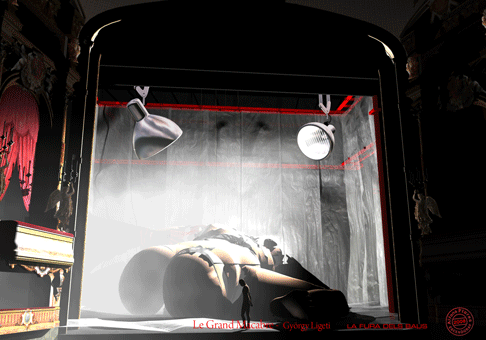25 Jun 2009
Ligeti’s Le Grand Macabre shocks Rome but only mildly
Le Grand Macabre is the only opera of György Ligéti, one of the major composers of the 20th century.

Le Grand Macabre is the only opera of György Ligéti, one of the major composers of the 20th century.
It is also one of the contemporary operas most frequently performed in Europe. Ligéti composed two different versions of Le Grand Macabre — the former had its debut in Stockholm in 1978, the latter in Salzburg in 1997. The main difference is that the second version replaces almost all the spoken parts with recitative. The production at the Teatro dell’Opera di Roma (June 18-23) is a world-wide affair. It started in Brussels a few months ago. From the Italian capital it will travel to Sidney, Australia. In the fall, it will have a long spell at the English National Opera in London and at the Liceu in Barcelona. It might go on to the US and other major European opera houses in 2010.
It is a grand, and very costly, production organized by the Catalan Group La Fura dels Baus , now very trendy — the Group has staged the entire Ring in Florence and Valencia; and it is booked by La Scala for a new production of Tannäuser, which will also be shown in Berlin and other major houses.
Le Grand Macabre reaches Rome with a reputation of scandal and even perversion. In January-February, the Brussels performances were well received by the audience but a few reviewers — including The New York Times — wrote about “debauchery” on stage. The new management of the Teatro dell’Opera advertised that the production is “for an adult audience”. At the opening nights, there were a few boos at some sexually explicit moments in the opera (in particular in the second scene of the first act) but the audience did not seem shocked. If it did, it was a very mild shock. Rome has been for centuries the Babylon of Europe and is accustomed to almost everything. There were several curtain calls, but (as it is often the case when a modern opera is on stage) a few rows and many boxes were empty.
Let us place Le Grand Macabre in its proper context. In his own comments to the second version of the opera, Ligéti said that he initially intended to compose a singspiel, but eventually he wrote a full opera because, among other things, it is difficult to find singers equally good at singing, acting and dancing. He also clarifies that, as a Hungarian, he was well-acquainted with operetta. Finally, his main operatic sources of inspiration were Monteverdi’s L’Incoronazione di Poppea and Verdi’s Falstaff. In short, even though Le Grand Macabre requires a huge orchestra and ten soloists, Ligéti thought of something light (the duration of the two acts is around 100 minutes) and very ironic. There are quotations from Verdi, Donizetti, Stravinsky, Mozart and, of course, Monteverdi in both the vocal and the orchestral score, which add irony to an otherwise late 20th century musical work (it is influenced by both the German Darmstadt School and the French ICRAM School. Along with numerous rhythmic orchestral passages, “declamation” slides easily into “arioso” and “duets”.

Irony also arises in the text. Based on a Belgian play, it is an allegory. In Bruegeland (a country based on Bruegel’s paintings), an asteroid is about to destroy every living thing on the planet. As the news breaks that death is near, the reaction of the populace is extreme sex (from the adolescent sex of a vigorous couple of teen agers to sadomasochistic sex of the Court’s astrologist and his wife). A few take up drinking, instead. The second part takes place in the corridors of power. As death arrives, intrigue and deception become pointless. Rather, it is better to join all in a crazy dance (a wild 15th century “ciaccona”). Mr. Death is expected to do all the killing and all the destroying, but finds more fun in joining the humanity in extreme sex and wild dancing . Thus, Bruegeland’s last day is postponed, perhaps forever.
In my opinion, La Fura dels Baus uses a very heavy hand in the stage production that clashes with Ligéti’s sophisticated and elegant score. The stage is dominated by a huge statue of woman in progressive decomposition where the characters come out from very private parts of her body. Irony does not seem to be a gift of the Catalan Group, even though, thanks to Ligéti’s music, it is manifest in the second part (especially in the “ciaccona”).
The orchestra responds extremely well to Zoltán Peskó’s conducting. Peskó is a compatriot and long-time friend of Ligéti. He is thus, fully equipped to show all the delicate nuances of the score. Chris Merritt has completed his transition from Bellini and Rossini coloratura belcanto to a high baritone for 20th century works. Brian Asawa is the best countertenor now available world-wide. Sir Willard White is as imposing as ever. Nicholas Isherwood is a master of early British music where it is quoted in the score. Caroline Stein is now a veteran of the double role a sensual Venus and a cynic Gepopo. Ning Liang is a vicious Nescalina. Annie Vavrille and Ilse Eerens are just delightful as the amorous teenagers.
Giuseppe Pennisi